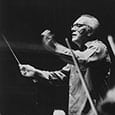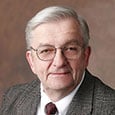Editor’s Note: This article originally appeared in the May 1997 issue of The Instrumentalist.
When you choose music for a concert, what approach or criteria do you use in deciding what will constitute a good concert?
My traditional opener is a work the entire ensemble can use to adjust to the temperature and acoustics of the hall and relax the nerves. I try to find something not too long, maybe about five to ten minutes in length, so latecomers won’t have to wait outside for an extended period of time. The second piece is often more profound or serious, such as a full symphony or a major work with multiple movements. This is a piece that could last 20 or 30 minutes.
I may pick a chamber work, such as Mozart’s Serenade “Grand Partita” or Gounod’s Petite Symphony, to begin the second half. Chamber pieces add variety. I always use the number of players called for in the score. Although my wind band has a pool of about 65 players, only one or two pieces on a program may use the entire group. The score always dictates the number of players.
The final work usually brings everybody on stage to receive the audience’s appreciation. I consider marches to be serious works, definitely crowd pleasers, and frequently program one or more on a concert. Also, I clearly focus on original wind repertoire rather than transcriptions, not to imply that there aren’t some fine transcriptions in the repertoire.
Can you identify more specific criteria to select music for a concert?
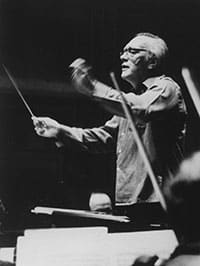 The process is a composite of many things. One of these is that I have to like the composition from some standpoint. It has to be good music, or good for the ensemble to play, or has terrific audience appeal. Another consideration is whether a piece will sustain the interest of students over the course of several rehearsals. The ability of the ensemble is also an important factor when selecting compositions. If the percussion section is weak, I would not try to do Persichetti’s Symphony No. 6 or music by Karel Husa (right). If the clarinet section is terrific, I may choose a work that features clarinets. I also consider the historical significance of a work, its intrinsic musical value, and how each piece fits into the complete program.
The process is a composite of many things. One of these is that I have to like the composition from some standpoint. It has to be good music, or good for the ensemble to play, or has terrific audience appeal. Another consideration is whether a piece will sustain the interest of students over the course of several rehearsals. The ability of the ensemble is also an important factor when selecting compositions. If the percussion section is weak, I would not try to do Persichetti’s Symphony No. 6 or music by Karel Husa (right). If the clarinet section is terrific, I may choose a work that features clarinets. I also consider the historical significance of a work, its intrinsic musical value, and how each piece fits into the complete program.
 If there are five weeks to prepare for a concert, I might choose a piece by Hindemith (left) or Schoenberg. With only one or two weeks to prepare, I would program something technically and musically less challenging. Once with only a couple weeks to prepare, I programmed a Sousa concert, which upset the graduate students. I insisted that Sousa was a good conductor, composer, and musician and that by performing his works and that by performing his works they would learn some interesting things.
If there are five weeks to prepare for a concert, I might choose a piece by Hindemith (left) or Schoenberg. With only one or two weeks to prepare, I would program something technically and musically less challenging. Once with only a couple weeks to prepare, I programmed a Sousa concert, which upset the graduate students. I insisted that Sousa was a good conductor, composer, and musician and that by performing his works and that by performing his works they would learn some interesting things.
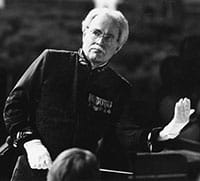 Keith Brion (right), who knows a lot about John Philip Sousa, came as a guest conductor and gave students a lesson in the performance practices of Sousa that those students will never forget. By the end of the experience, they understood how Sousa interpreted and used accents to embellish his music. Some students did not change their views about an all-Sousa program, but most learned something in the process. If our sessions exclusively on Sousa had gone on for many weeks, I would have had a rebellion on my hands, but this concert had incredible appeal to a large audience and was a good way to relax a bit and end the school year.
Keith Brion (right), who knows a lot about John Philip Sousa, came as a guest conductor and gave students a lesson in the performance practices of Sousa that those students will never forget. By the end of the experience, they understood how Sousa interpreted and used accents to embellish his music. Some students did not change their views about an all-Sousa program, but most learned something in the process. If our sessions exclusively on Sousa had gone on for many weeks, I would have had a rebellion on my hands, but this concert had incredible appeal to a large audience and was a good way to relax a bit and end the school year.
I screen out music that is trite or too predictable. I also look at whether a piece is crafted with parts that are characteristic for each instrument, how the composer treats each idea, and whether too many ideas are included and developed poorly or not at all. Directors should analyze each piece to determine whether thematic material or textural ideas are developed throughout the composition. I also look for intellectual significance and emotional content because a worthwhile work has to say something. However, a good conductor can sometimes achieve an emotional performance of a bad piece by experimenting with tempos, textures, dynamics, balance, and blend.
When preparing for an interpretation of a work, to what extent do you investigate its historical context?
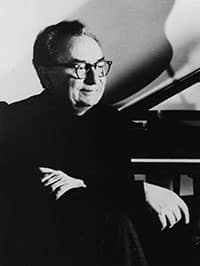 I spend a great deal of time with each score. If I was preparing a Persichetti (left) symphony and did not know the work, I would probably spend between 20 and 40 hours studying the score. The first step is to gather general information about the composer, arranger, publisher, level of difficulty, type of score (concert pitch or transposed) and how it is laid out. I examine the orchestration for thin or thick scoring, contrasts, choirs or groupings of instruments, special effects, or aleatoric writing. Textural and atonal writing without melody, as opposed to melodic and tonal writing are particularly important in wind literature because of the vast array of the orchestration. A conductor should consider the size of the ensemble and how his choice of doublings will affect the texture of the composition.
I spend a great deal of time with each score. If I was preparing a Persichetti (left) symphony and did not know the work, I would probably spend between 20 and 40 hours studying the score. The first step is to gather general information about the composer, arranger, publisher, level of difficulty, type of score (concert pitch or transposed) and how it is laid out. I examine the orchestration for thin or thick scoring, contrasts, choirs or groupings of instruments, special effects, or aleatoric writing. Textural and atonal writing without melody, as opposed to melodic and tonal writing are particularly important in wind literature because of the vast array of the orchestration. A conductor should consider the size of the ensemble and how his choice of doublings will affect the texture of the composition.
I next identify tempo changes, key signatures, and any unusual directions, such as Grainger’s “to the fore” and unusual foreign words or unfamiliar terminology. In the beginning stages, I sing through the score at a manageable tempo and try to hear the melody and harmony without using a piano or recordings. However, after the initial study, I listen to as many recordings of a piece as possible. I put them away once rehearsals begin to prevent being overly influenced by someone else’s ideas so that the final interpretation is mine.
After attempting to sing through a score, I often use a piano to learn the harmonic structures, cadences, modulations, and unusual chords. At this point, I make note of all meter changes, peculiar rhythms, tempo relationships, and tempo interruptions such as ritards, accelerandos, and fermatas. I find it helps to mark tempo changes, indicating the relationship between the old and new tempo. Regardless of whether a conductor adheres to the suggested metronomic markings, the relative change in tempo is important.
Finally, I identify the primary lines throughout the score and indicate which instruments have that line and which instruments play countermelodies. After analyzing a piece, I diagram the work to indicate introductions, themes, and transitions. This culminates in an outline, usually on one 81/2 x 11-inch sheet of paper. A conductor who thoroughly understands a piece and has good diagram of it should be able to conduct the work without a score.
Do you advocate score memorization?
Score memorization is not a primary goal, but it can be inevitable in the process of learning a piece. Memorization is sometimes dangerous; some directors who conduct from memory tend to be overly flamboyant. When I ask students to conduct from memory, I remind them that the audience comes to hear the music and not to let gestures detract from that end.
Do you have a specific method for marking scores?
Although I mark scores less at this stage in my career than I did in the past, I use a color-coded system to highlight dynamics, tempos, melodic lines, and cues. Some conductors mark scores so heavily that there isn’t any white left on the page when they are finished, but this is unnecessary if you know the score well.
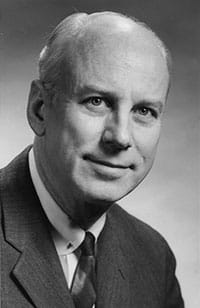 Score marking procedures differ according to the piece and the group. Basically, I highlight all dynamics, marking loud dynamics in red and soft dynamics in blue. I highlight primary lines in a light color, usually yellow, and draw big lines over whole phrases. As a young conductor I marked scores quite heavily, sometimes making them almost illegible after several performances. In a work such as For the Unfortunate by H. Owen Reed (left), which is pointillistic writing that has instruments entering in quick succession out of rhythm, I use a different marking principle and simply mark the score to show the location of instruments in the ensemble. To cue an entrance, I would not write the name of the instrument in the score but just put an arrow pointing toward the location of the player in the ensemble. Some directors call this cheating but it’s safe.
Score marking procedures differ according to the piece and the group. Basically, I highlight all dynamics, marking loud dynamics in red and soft dynamics in blue. I highlight primary lines in a light color, usually yellow, and draw big lines over whole phrases. As a young conductor I marked scores quite heavily, sometimes making them almost illegible after several performances. In a work such as For the Unfortunate by H. Owen Reed (left), which is pointillistic writing that has instruments entering in quick succession out of rhythm, I use a different marking principle and simply mark the score to show the location of instruments in the ensemble. To cue an entrance, I would not write the name of the instrument in the score but just put an arrow pointing toward the location of the player in the ensemble. Some directors call this cheating but it’s safe.
Do you add marks to scores as rehearsals progress?
Yes, I add marks all the time; I write in the score with a pencil to keep track of ideas during rehearsals and erase the marks if I change my mind later. My Persichetti scores are a mess because I’ve changed my mind about his music as I’ve grown older and become better acquainted with the man. For example, I choose tempos in some of Persichetti’s music that I feel are musically satisfying but not what he indicated in the score. I knew him well enough to know that he wouldn’t care. I bring everything I know into the interpretation of that score, including my knowledge of the composer.
Conductors should understand the historical significance of composers and the period in which they wrote a piece in order to make intelligent decisions about how to interpret a work. The difficulty lies in offering a subjective interpretation of a piece while remaining loyal to the composer’s intent. Fortunately, much of the band music we play is written by composers who are still alive; this is a fantastic opportunity for a conductor to talk to the composer or acquire a recording of the work with the composer conducting. However, I have learned that the composer doesn’t always come up with the best interpretation.
Vincent Persichetti was one of my idols, so I often invited him to guest conduct my bands. It seemed to me that every time Persichetti conducted one of his pieces, he would take a different tempo. One day I asked him if he really wanted the tempo he had chosen, and he said, “Oh yes, I think that sounds great today; this band plays that tempo very well.” It was considerably faster than indicated in the score, but this was the tempo he liked that day. To have a composer of his stature say that was enlightening.
On the other hand, Stravinsky became upset if anyone varied his tempos even the slightest amount. He wanted his music played exactly as he had written it, without compromise, so we have examples of two great minds and two completely different ideas about interpreting their compositions.
Is your preparation for a rehearsal with a large ensemble much different than it would be for a small group?
The simple answer is no. The preparation is similar, but rehearsals may differ with the size of the group. I try to use a chamber music approach with all ensembles and try to make players see all music as chamber music. I want students to be able to hear all the other parts while playing. If a director has to conduct beat patterns throughout an entire piece, the ensemble has a big problem. I try to be a metronome as little as possible and instead be an interpreter who teaches students what to listen for in each measure. Approaching your group as a chamber ensemble will help this technique.
To what extent do you use score analyses and articles by other composers and colleagues in preparing a work?
I read as many articles as I can find and study as many interpretations of a piece as possible. Conductors should use every resource available to learn the score, including recordings, which offer examples of both good and band interpretations of a piece.
How do you identify the style characteristics of a composition?
The period in which the music was written or the composer’s intent of the composition, regardless of when it was written, should be ascertained. Knowledge of music history and performance practices in different historical periods is important. The thematic material in a composition should be played in an authentic and consistent style. I often rehearse all sections of a composition that use the same theme, motif, or style, even when written in another key or scored differently so students hear the similarities. This makes better musicians of them, and makes them aware of style, and increases rehearsal efficiency.
What are some of the steps you take in preparing for a performance?
After the music is learned and ready for performance, it is important to play pieces from beginning to end as often as possible so students learn to recover if something goes wrong during a performance. Directors in academia are under tremendous pressure to produce exceptional concerts because each program is usually given only once. We prepare repertoire, take it to the concert hall, and start a new program the following day, unlike professional groups that take a concert on the road or go off-Broadway to hone a work before doing it for real.
Educational ensembles usually have only one chance to do it right. I insist on a dress rehearsal in the concert hall before every performance so I can stand in the house and listen to the ensemble from the audience’s perspective. At this point, I may rebalance the ensemble to produce the sound I want the audience to hear. When the music sounds balanced from the house, I go up on stage and listen to how this adjustment sounds from the podium. If I had asked the tubas to play out to be heard in the audience, I don’t want to react differently when I am on the podium because they seem too loud from that position.
During the performance, conductors should not show any emotion if a problem arises or something makes them angry. Showing these emotions could affect the performance. A conductor should put these feelings aside and concentrate on the music. When a conductor steps onto the podium for a performance, the initial responsibility is to set the correct tempo. I look for the place in each composition that helps me determine the opening tempo, and that may not be the music in the first few measures.
How do you teach conducting techniques to others?
The best way to teach conducting is one on one, but all students can learn by watching other conductors at work. With all students, including graduate students, I always reiterated the basic skills. The conducting field is an imaginary box from eye height to belt buckle and from shoulder to shoulder. For lyrical lines, the conducting field is the same size but turned on its side. Marches usually call for a vertical field, while lyrical music, such as Irish Tune from County Derry, calls for a horizontal pattern. To conduct lyrical lines, students might imagine that they are standing in water up to their rib cage and conduct in broad horizontal lines without touching the water. It’s amazing how their lyrical conducting improves. Conductors can use the area outside this imaginary conducting field to emphasize an accent or a dynamic or to cue with clarity.
The essence of conducting is speaking with gestures instead of the voice; talkative conductors are easy to ignore. One technique to demonstrate this to conducting students is to forbid them to talk in rehearsal, even to the point of putting rehearsal letters on the chalkboard for them to point to and indicate where to start or where they are directing their comments. This exercise teaches them to communicate phrasing and dynamics with only conducting gestures and facial expressions. It’s also amazing how quiet the ensemble becomes when the conductor is completely silent. We record all rehearsals so student conductors can see their themselves and discuss their progress in private. These recordings are also used in conducting seminars so students can critique and learn from each other.
How should conducting techniques be balanced with score preparation in college conducting courses?
Score preparation was certainly a major part of my conducting classes. This was followed by preparation of a composition for rehearsal and performance with conducting gestures. Conducting classes often devote considerable time to gestures and little to score study, even though score study is the basis for interpretation. I always ask students to evaluate the sounds they create. Often, after listening to recordings of their rehearsals, they realize that the music sonorities are terrible. They get so involved in the execution of the notes and the precision of the ensemble and their gestures that they forget to listen to the sounds of the ensemble.
The measure of success for a conductor usually is how the ensemble sounds. A conductor’s behavior and personality determine effectiveness on the podium. You can be a scholar in music and a skilled conductor with a great ear, but if you cannot relate to the musicians and motivate them, your chances of success are limited. Some of the best ensembles are led by directors who are obviously skilled but who also have pleasant dispositions and good manners. They dress and speak well, and continue working to improve their skills as conductors.
